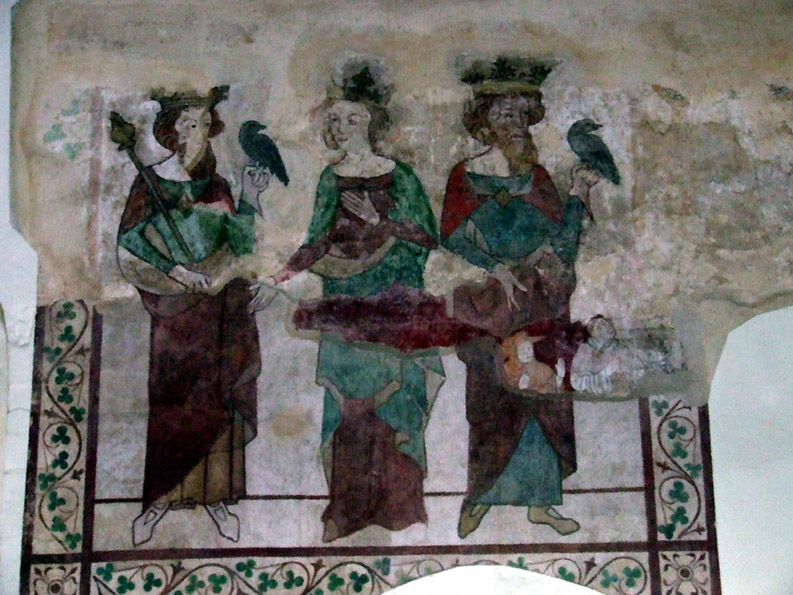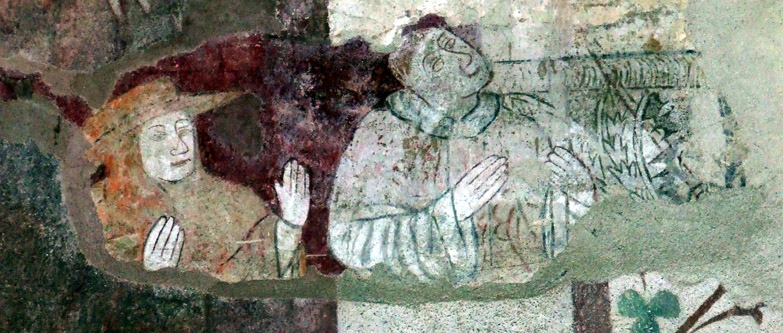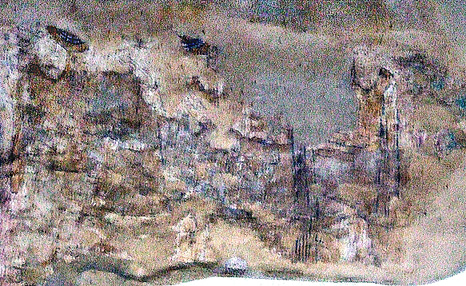Lutterworth, Leicestershire (†Leicester) C.14
The Three Living & The Three Dead

This is one of the most problematic paintings in the English church. The proto-Reformer John Wycliffe, who died in 1384, was for the last ten years of his life Rector of Lutterworth, and must have seen this painting, but what he thought about it, or about the Doom painting over the chancel arch, remains a matter of conjecture. The three living, a royal hawking party, as so often, stand at the left, and the three skeletal but partly shrouded dead immediately to the right (the dead, in a very poor state of preservation now, are nevertheless reproduced in a little more detail lower down this page). The upper part of the painting was restored under the aegis of Sir Giles Gilbert Scott in Victorian times, and the replastered area at the top shows that this amounted to a re-painting.
As they stand now, the Three Living (the central figure a queen), are clear enough, and certainly of very high quality. But in 1983-4, when Eve Baker probed the plaster preparatory to her own restoration, the small detail enlarged at the right emerged. This was painted on a later (but still 14th century) layer of plaster, making it part of another painting superimposed on the Three Living. What happened to the rest of this painting (assuming it was completed), and what it originally showed, is frankly, anyone’s guess.

Visible on the uncovered section are two ecclesiastics, on the left a cardinal in his red hat, and further right beside him a tonsured man in a white alb holding an upright staff of some kind. Beyond this man is a partial view of a complicated decorative detail featuring a roundel with a rim patterned with leaves. There are also some sharply pointed details, conceivably belonging to a crown of thorns, and part of something resembling a lance slanting through the central roundel. These details may have added up to a depiction of the Instruments of the Passion. I suspect that there may have been two other figures beyond this central decoration, and that this was a depiction of the four Latin fathers of the Church – Jerome, in the cardinal’s hat, possibly Gregory (in the white alb) with figures of Augustine and Ambrose further right. This is purest conjecture, of course, but it would meet the demands of symmetry and be consonant with what we know about Wycliffe’s attitude to the Scriptures and the place of the Fathers in contemporary Church teaching.¹ Both men are looking upwards to the right, and ‘Jerome’ has both hands raised in adoration. Possibly a painting of the Crucifixion was, or was intended to be, painted on the area of wall where the fragments of the Three Dead are now. Further examination of the plaster layer had to be abandoned because of its instability.
Wycliffe’s attitude to images seems to have been neutral, much like Martin Luther’s later. He inveighed against the worship of images, certainly, but that was an entirely orthodox position in his day. He would have had no objection to church paintings, probably regarding them as useful aids to understanding of the tenets of faith, for those who had yet to reach a full understanding of hard doctrines such as Justification by Faith. Aesthetics is another matter entirely, and Wycliffe might have simply disliked the legendary tale of the the Three Living and the Three Dead, regarding it as superstition. Or – and this is much more likely, I think, he may have had nothing at all to do with the additions and whitewashing here, leaving such matters to his stipendiary curate, John Horn, and his churchwardens, whose province the church fabric properly was anyway. Above all, it should be remembered that Wycliffe can hardly have spent any time at all at Lutterworth; he went back up to Oxford in 1368 to study theology and continued there until at least 1382 when he became Professor of Theology at the University. Only near the end of his life would he return to Lutterworth, and he died there in 1384. The idea that the most eminent English churchman and scholar of his day would concern himself one way or the other with what was painted on a village church wall needs to be resisted.

The painting is a fine one nevertheless, and it is a great shame that the part of it showing the Three Dead is in such a poor and fragmentary state. It is reproduced at the left and it should be possible to make out some of the perfectly round, grinning moon-face of the figure on the left, who has his skeletal right hand raised. The central figure is also pointing to the left – towards the Living – and the rightmost figure’s bony arms and hands dangle at his sides. The anatomy must have been quite impressive once, and it is certainly accurate, for example in the carefully observed deeply hollowed-out collarbones. The painting of the subject at Charlwood is probably the best example for comparison.
The only other remaining painting at Lutterworth is a Doom over the chancel arch, the upper part of it heavily repainted by Giles Gilbert Scott in a painfully sentimental, highly-coloured fashion. The lower part has had less Victorian interference, though, and it has some very interesting features. It will be here later in the year.
Website for Lutterworth Church – you can download the church guide in PDF format.
¹ For more on Wycliffe in Oxford, Margaret Deanesly, Emeritus Professor of History, University of London, The Significance of the Lollard Bible:The Ethel M. Wood Lecture delivered before the University of London on 12 March, 1951 is a short, useful and thoroughly reliable introduction to Wycliffe available as a PDF.
† in page heading = Diocese